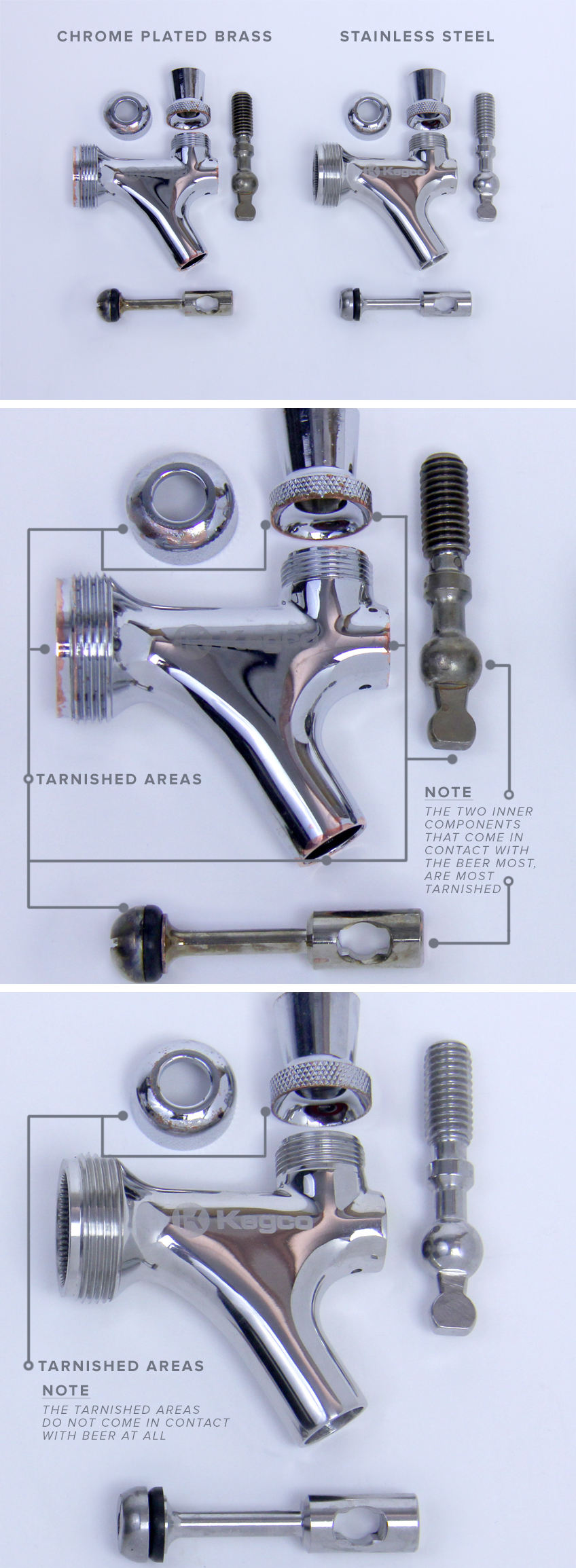Q: What are the pros and cons of the different types of faucets?
A: Depending on your style preferences, preexisting dispensing equipment, and the type of beer that you expect to be serving, there are several different types of faucets that you can choose from:

Standard |
|

European |
|

Rototap |
|

Stout (Nitrogen) |
|

Perlick |
|

Creamer |
|

Self-Closing |
|

Flow Control |
|
Q: What are the pros and cons of the different faucet finishes?
A: Beer faucets can be purchased in chrome-plated, stainless steel, and polished brass finishes. Chrome faucets are generally brass faucets with a shiny silver chrome-plated finish, making the difference between chrome-plated and brass faucets purely aesthetic. Chrome and PVD brass faucets are economical so they're great for a brewer on a budget, but they may need to be replaced over time if the brass becomes exposed.
Chrome has no negative effect on the quality of your beer, but beer that comes into contact with brass will react and pick up a metallic off-taste. It is also difficult to clean exposed brass. The chrome coating on these parts rarely wears away on the outside, but cleaning and beer flow will eventually expose the brass on the inside of these parts, bringing the beer in contact with the brass. If your system already contains chrome-plated brass components, inspect the beer contact surfaces regularly for exposed brass and replace those components immediately when this is detected.
Brewers recommend stainless steel draft parts whenever possible to avoid brass contact. Stainless steel is a much stronger material than brass, making faucets with stainless steel levers much more durable if you plan on frequently using the faucet. In addition to being resistant to chemicals and inert in contact with beer, they are less porous than brass, making them more sanitary, less likely to harbor bacteria and easier to clean, helping to maintain high quality draft dispense.

For the above illustration, we took a chrome plated brass faucet and a stainless steel faucet and soaked them in acid line cleaner for 5 days. This simulated the type of tarnish you can expect on a faucet over time, depending on the amount of use and the frequency of cleaning. As you can see, there is some tarnish on the chrome plating on the outside of the chrome plated brass faucet, but the plunger and lever that are on the inside of the faucet and have the most contact with your beer are the most tarnished areas. The stainless steel faucet shows no signs of wear on any of the parts that contact beer. This is precisely the reason that stainless steel, although slightly more expensive, is a better choice for your draft beer system fittings for the long haul.


 Single Faucet Kegerator Beer Dispensers
Single Faucet Kegerator Beer Dispensers Dual Faucet Two Tap Kegerators
Dual Faucet Two Tap Kegerators Triple Faucet Three Tap Kegerators
Triple Faucet Three Tap Kegerators Undercounter Built-In Kegerators
Undercounter Built-In Kegerators Outdoor Kegerator Beer Dispensers
Outdoor Kegerator Beer Dispensers Commercial Kegerators
Commercial Kegerators Mini Kegerators
Mini Kegerators Cold Brew & Nitro Coffee Dispenser Kegerators
Cold Brew & Nitro Coffee Dispenser Kegerators Carbonated Water Kegerators
Carbonated Water Kegerators Home Brew Kegerators
Home Brew Kegerators 15" Kegerators
15" Kegerators Kombucha Equipment
Kombucha Equipment Guinness® Dispensing Kegerators
Guinness® Dispensing Kegerators Vending Kegerators
Vending Kegerators Wine Kegerators
Wine Kegerators Kegerator Cabinets
Kegerator Cabinets Kegerator Covers and Accessories
Kegerator Covers and Accessories Kegerators
Kegerators Kegerator Conversion Kits
Kegerator Conversion Kits Kegs & Keg Accessories
Kegs & Keg Accessories Beer Faucets
Beer Faucets Beer Shanks
Beer Shanks Draft Beer Towers
Draft Beer Towers Keg Taps Couplers
Keg Taps Couplers Regulators & Gas Equipment
Regulators & Gas Equipment Beer & Gas Line Hose
Beer & Gas Line Hose Co2 and Nitrogen Air Tanks
Co2 and Nitrogen Air Tanks Beer Line Cleaning Equipment
Beer Line Cleaning Equipment Drip Trays
Drip Trays System Fittings
System Fittings Jockey Boxes
Jockey Boxes Keg Beer Party Pumps
Keg Beer Party Pumps Glassware
Glassware Guinness® Dispensing Equipment
Guinness® Dispensing Equipment Remote Glycol Systems
Remote Glycol Systems Wine Cooler Refrigerators
Wine Cooler Refrigerators Wine Cellar Cabinets
Wine Cellar Cabinets Wine Racks
Wine Racks Cooling Units
Cooling Units Wine Dispensing Systems
Wine Dispensing Systems Wine Accessories
Wine Accessories Howard Miller Wine & Spirits Furniture
Howard Miller Wine & Spirits Furniture Wine Making
Wine Making Nitro Hot Draft System
Nitro Hot Draft System Ready to Drink Bag-in-a-Box Coffee Dispensing Equipment
Ready to Drink Bag-in-a-Box Coffee Dispensing Equipment Nitrogen Infusers
Nitrogen Infusers Nitrogen Tanks & Generators
Nitrogen Tanks & Generators Nitrogen Beer Regulators
Nitrogen Beer Regulators Nitro Cold Brew Coffee Kegs
Nitro Cold Brew Coffee Kegs Cold Brewed Coffee Tools
Cold Brewed Coffee Tools Espresso Machines
Espresso Machines Cleaning Equipment
Cleaning Equipment Outdoor Appliances
Outdoor Appliances ADA Appliances
ADA Appliances Panel Ready Appliances
Panel Ready Appliances Commercial Grade Appliances
Commercial Grade Appliances Beverage Centers
Beverage Centers Refrigerators
Refrigerators Drawer Refrigerators
Drawer Refrigerators Ice Makers
Ice Makers Water Dispensers & Accessories
Water Dispensers & Accessories Freezers
Freezers Home Brew Equipment Kits
Home Brew Equipment Kits Fermentation Equipment
Fermentation Equipment Boiling and Mashing Equipment
Boiling and Mashing Equipment Home Brew Beer Kegs
Home Brew Beer Kegs Home Brew Kegerator Conversion Kits
Home Brew Kegerator Conversion Kits Brewing Tools
Brewing Tools Home Brew Ingredients
Home Brew Ingredients Cleaning Chemicals
Cleaning Chemicals Test Equipment
Test Equipment Home Brew Beer Bottles and Bottling Equipment
Home Brew Beer Bottles and Bottling Equipment Brewery Fittings
Brewery Fittings Draft Beer Equipment
Draft Beer Equipment Homebrewing Equipment
Homebrewing Equipment Wine Equipment
Wine Equipment Luxury Appliances and Refrigeration
Luxury Appliances and Refrigeration Coffee Equipment
Coffee Equipment Kombucha
Kombucha The Beverage Blog
The Beverage Blog Frequently Asked Beer Questions
Frequently Asked Beer Questions Shop by Brand
Shop by Brand Shop by Category
Shop by Category